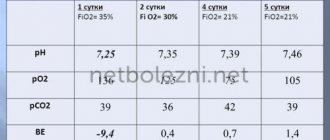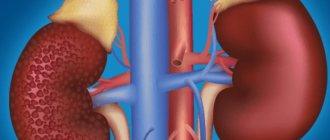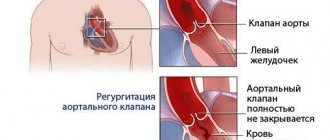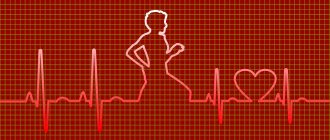Adrenal diseases
are considered severe endocrine pathologies, because lead to serious disruptions in the functioning of many organs and systems of the human body.
The adrenal glands are small paired organs located above the upper poles of the kidneys. The main task of the adrenal glands is the production of hormones that carry out vital processes in the body (glucocorticoids, mineralcorticoids, estrogens, adrenaline and norepinephrine, etc.)
Main causes of adrenal diseases
are usually associated with excessive production or deficiency of hormones of the adrenal glands themselves or pituitary hormones (ACTH).
About adrenal function
The adrenal glands are two endocrine glands located on top of the kidneys. Although the size of these glands is very small and their total weight is up to 12 grams, they perform very important functions in the body. The functioning of the entire body depends on the proper functioning of the adrenal glands.
What are the adrenal glands for?
The adrenal glands are made up of an outer layer (cortex) and an inner layer (medulla). The cortex occupies about 90% of the volume of the entire gland, and only 10% is the medulla. The hormones produced by the cortex and medulla are completely different.
The cortex synthesizes:
- hormones responsible for water-salt metabolism
- hormones responsible for carbohydrate metabolism
- sex hormones.
The medulla produces:
- adrenalin
- norepinephrine
- peptides.
Each of the functions of the adrenal glands is critically important for the human body, and a failure in the synthesis of any hormone can lead to death or disability.
A comprehensive laboratory test aimed at assessing the functioning of the adrenal glands.
Synonyms Russian
Adrenal examination; adrenal function.
English synonyms
The function of the adrenal gland.
What biomaterial can be used for research?
Venous blood.
How to properly prepare for research?
- Limit carbohydrate intake for 14-30 days before the test.
- Eliminate alcohol from your diet for 24 hours before the test.
- Children under 1 year of age should not eat for 30-40 minutes before the test.
- Children aged 1 to 5 years should not eat for 2-3 hours before the test.
- Do not eat for 12 hours before the test; you can drink clean still water.
- Within 14-30 days before the study, discontinue (in consultation with your doctor) diuretics, antihypertensive drugs, steroids, oral contraceptives and estrogens.
- Avoid (in consultation with your doctor) taking renin inhibitors for 7 days before the test.
- Avoid (in consultation with your doctor) taking estrogens and androgens within 48 hours before the test.
- Completely avoid (in consultation with your doctor) taking medications for 24 hours before the test.
- Avoid physical and emotional stress for 72 hours before the test.
- Before drawing blood in a sitting position, it is recommended to rest or remain in this position for 120 minutes.
- Do not smoke for 3 hours before the test.
General information about the study
The adrenal gland consists of two different parts: the cortex and the medulla, which have different origins, structures and functions.
The medulla produces catecholamines, which include two main hormones: adrenaline and norepinephrine. They affect the activity of the cardiovascular system, glandular epithelium, processes of carbohydrate and fat metabolism, and thermogenesis. The cortex occupies about 70-80% of the organ's volume and produces a large group of hormones - corticosteroids. The cortex is divided into zona glomerulosa, zona fasciculata and zona reticularis. There are over 40 known substances isolated from this layer of the adrenal glands, some of which have hormonal activity. Corticosteroids affect various types of metabolism, the immune system and the course of inflammatory processes.
Hormones of the adrenal cortex are divided into two groups according to their action: glucocorticoid and mineralocorticoid, the former mainly affect the metabolism of carbohydrates, and the latter - the metabolism of minerals. Sex steroid hormones are synthesized in the reticular zone. It should be noted that this is a conditional division and the effect of hormones on metabolism is complex. Glucocorticoid hormones: cortisol, cortisone, corticosterone are synthesized in the middle (fascicular) layer of the adrenal cortex. They have a significant impact on the metabolism of carbohydrates and proteins. Minerolocorticoid hormones: aldosterone and deoxycorticosterone mainly regulate the metabolism of water and minerals.
Cortisol is a hormone, the main representative of glucocorticoids, synthesized in the zona fasciculata of the cortex. It is involved in the regulation of blood pressure, the metabolism of proteins, fats, carbohydrates, and protecting the body from stress. Stimulation of the synthesis and secretion of cortisol is regulated by adrenocorticotropic hormone (ACTH) via a negative feedback mechanism. ACTH is a hormone of the anterior pituitary gland, which is secreted under the influence of tropic factors of the hypothalamus according to a certain daily rhythm.
An increase in the level of cortisol in the blood is observed in Itsenko-Cushing syndrome. Its development may be associated with a benign or malignant tumor of the adrenal glands, as well as with long-term use of glucocorticosteroid drugs. It is characterized by symptoms such as obesity, the appearance of stretch marks on the skin of the abdomen, increased blood pressure, increased blood glucose levels, and impaired mineral metabolism. Also, an increase in the secretion of this hormone can be observed with ectopic release of ACTH in paraneoplastic syndrome by tumors of non-pituitary origin and other localization.
With primary adrenal insufficiency and Addison's disease, the production of glucocorticoids and mineralcorticoids decreases and the secretion of ACTH increases. A decrease in ACTH concentration can be observed with hypofunction of the adrenal cortex due to weakened pituitary function, with Itsenko-Cushing syndrome, with the administration of glucocorticoids.
Aldosterone is a hormone that is synthesized from cholesterol in the cells of the zona glomerulosa of the adrenal cortex. It regulates the maintenance of normal concentrations of sodium, potassium in the blood and normal circulating blood volume, and therefore blood pressure. Aldosterone mainly acts on the distal tubules of the kidney structure, stimulating the reabsorption of sodium ions and the secretion of potassium and hydrogen ions. There are daily fluctuations in aldosterone levels. An increase in the concentration of this hormone is observed in primary or secondary hyperaldosteronism. Primary hyperaldosteronism can occur due to a hormone-producing tumor of the adrenal gland, aldosteroma, or adrenal hyperplasia. Secondary hyperaldosteronism may result from decreased blood flow to the kidneys, decreased blood pressure, or decreased sodium levels, resulting in increased plasma renin activity. High aldosterone levels increase sodium reabsorption and potassium loss by the kidneys, leading to fluid and electrolyte imbalance. A decrease in hormone concentration is observed with damage to the adrenal glands or impaired aldosterone biosynthesis.
Sodium, potassium and chlorine are vital electrolytes, and adrenal hormones play a significant role in maintaining their levels. They are involved in maintaining water-electrolyte balance, acid-base balance, in the process of muscle contraction, conducting nerve impulses, maintaining normal balance of cells and the intercellular matrix.
What is the research used for?
- For the diagnosis of Itsenko-Cushing syndrome, Addison's disease;
- for differential diagnosis of the disease and various forms of Itsenko-Cushing syndrome;
- to assess the effectiveness of treatment for Itsenko-Cushing syndrome, Addison's disease;
- to evaluate the effectiveness of surgical or therapeutic treatment of hormone-synthesizing tumors;
- for screening diagnosis of primary or secondary hyperaldosteronism in combination with the determination of other hormones;
- to determine possible causes of imbalance of electrolytes: potassium, sodium, chlorine.
When is the study scheduled?
- If you suspect Itsenko-Cushing syndrome or disease (symptoms: obesity, the appearance of specific stretch marks on the skin of the abdomen, muscle dystrophy, increased blood pressure, increased blood glucose levels, impaired mineral metabolism) or Addison's disease (symptoms: muscle weakness, fatigue, decreased blood pressure, hypoglycemia, skin pigmentation);
- when monitoring the treatment;
- if ectopic release of ACTH is suspected in paraneoplastic syndrome;
- if you suspect dysfunction of the adrenal cortex;
- for postoperative and post-traumatic conditions;
- for a comprehensive diagnosis of the causes of increased blood pressure, including in young people;
- if you suspect water and electrolyte disturbances;
- with symptoms of hyponatremia (weakness, lethargy, confusion) and hypernatremia (thirst, decreased amount of urine output, convulsions, agitation;
- for symptoms of hypokalemia (malaise, thirst, polyuria, anorexia, low blood pressure, vomiting, decreased reflexes, ECG changes with decreased T waves) and hyperkalemia (excitability, diarrhea, cramps, oliguria, cardiac arrhythmia with sharp T waves and progressive gastric fibrillation) ;
- if acidosis or alkalosis is suspected with a possible deterioration of the condition, accompanied by prolonged vomiting, weakness, disorientation in space, impaired breathing and heart rhythm.
What do the results mean?
Reference values
For each indicator included in the complex:
- [06-064] Serum potassium
- [06-065] Serum sodium
- [06-066] Chlorine in serum
- [08-012] Adrenocorticotropic hormone (ACTH)
- [08-013] Aldosterone
- [08-030] Cortisol
Increases and decreases in indicators are varied and depend on the cause. Since some hormones interact through a negative feedback mechanism in the same disease or syndrome, the amount of one indicator can be increased and another decreased, and vice versa.
What can influence the result?
- Increased amount of salt in the diet, taking medications: diuretics, antihypertensives, steroids, non-steroidal anti-inflammatory drugs, oral contraceptives and estrogens;
- pregnancy.
Adrenal diseases
Diseases of the adrenal glands are usually divided into two subgroups, depending on the structure of this organ:
- bark diseases
- diseases of the brain.
Main groups of diseases
- diseases with excessive synthesis of hormones (hyperfunction), in particular, Itsenko-Cushing syndrome, corticoestroma, androsteroma, etc.;
- diseases with insufficient synthesis of hormones (hypofunction): chronic and acute adrenal insufficiency;
- adrenal dysfunction (decreased production of some hormones and excessive synthesis of other hormones): various forms of congenital dysfunction of the adrenal cortex.
How are adrenal tumors treated at the Treatment and Rehabilitation Center?
A serious problem when removing an adrenal tumor is the body’s unpredictable reaction to changes in hormonal levels. Directly during the operation, a patient with pheochromacytoma (tumor of the brain) may develop severe circulatory disorders. Therefore, it is so important that the intervention is performed by surgeons and anesthesiologists with extensive experience in managing such patients.
During the operation, as a rule, the entire adrenal gland is removed along with the tumor located there - this provides confidence in a complete cure. The function of producing hormones is taken over by the paired organ. Sometimes he cannot cope with the load - and then the endocrinologist in the postoperative period prescribes hormonal therapy to the patient, which allows him to avoid problems with well-being.
| Specialists of the Treatment and Rehabilitation Center of the Ministry of Health of Russia have accumulated unique experience in performing laparoscopic (through 1-3 punctures) operations to remove benign and malignant adrenal tumors up to 10 cm in diameter. Such an intervention does not leave noticeable scars and is much easier for the patient to tolerate than traditional “open” surgery. It is no coincidence that patients not only from Moscow and the Moscow region, but also from many other regions of our country turn to the LRC for help, because gentle treatment is insurance against postoperative complications and allows patients to return to normal life as soon as possible after surgery! |
Symptoms
Symptoms of adrenal gland diseases appear gradually.
You may notice in yourself
- increased fatigue,
- muscle weakness,
- weight loss,
- nausea,
- low blood pressure.
Signs of dysfunction of the adrenal glands can also be: sleep disturbance, sexual weakness in men, changes in the cycle in women, tinnitus, osteoporosis, etc.
One of the signs of insufficient production of hormones by the adrenal glands is darkening in some areas of the skin (folds on the arms, elbows, around the nipples, etc.).
Beam zone
This zone is responsible for the synthesis of glucocorticosteroids. They are responsible for protein, carbohydrate and fat metabolism in the body. Closely related to the production of insulin and catecholamines.
Glucocorticosteroids reduce the immune response, inhibit inflammatory processes, gradually suppressing them.
One of the hormones in the zona fasciculata is cortisol. It takes part in carbohydrate metabolism and preserves the body's energy resources. The level of cortisol in the body is constantly changing - there is more of it in the morning than in the evening or at night.
Diagnosis and treatment of adrenal diseases
Diagnostics
1. To make an accurate diagnosis, the doctor will definitely prescribe a blood test for hormone levels.
2. To clarify the structure of the adrenal glands, their size and possible deviations, you should also undergo an ultrasound scan of the adrenal glands.
3. If there is a lack of information, tomography or radiography is prescribed.
You can undergo all these laboratory and instrumental tests in our clinic in St. Petersburg.
Treatment
Treatment of adrenal diseases is prescribed after a thorough and comprehensive examination and an accurate diagnosis.
For diseases characterized by insufficient production of hormones, the main method of treatment is taking hormonal medications .
In diseases accompanied by excessive production of hormones, it is sometimes impossible to find out the cause.
In some cases, the cause of excess hormones is neoplasms, which are almost always benign and often develop into a cyst. Treatment of tumors is carried out using gamma irradiation, but only after determining the exact location using MRI. In some cases, treatment includes surgery .
Diseases characterized by excess production of adrenaline are often caused by a tumor in the adrenal medulla and are treated by removing the tumor .
Diagnostics
Visualization of education
It is very important to know the characteristics of a formation that will help you understand whether it is benign or not. In 2-5% of cases, the finding turns out to be cancer, and most adrenal tumors, fortunately, are benign (about 95-97%). When performing an ultrasound, CT or MRI, special attention should be paid to indicators such as size, shape, structure and growth in the dynamics of the formation.
Conditional criteria for adrenocortical cancer:
- size more than 4 cm in diameter;
- the shape of malignant formations in most cases is irregular, with unclear, uneven edges;
- the structure of malignant formations is heterogeneous, of varying density;
- The growth in the dynamics of malignant tumors is quite rapid: more than 2 cm per year.
Conditional criteria for metastasis to the adrenal gland:
- size less than 3 cm in diameter;
- the shape of the site of stasis in most cases is round with fuzzy, uneven edges;
- the structure of the metastasis is heterogeneous, of varying density;
- the growth in the dynamics of metastasis does not differ according to the pattern.
Hormonal examination
All patients with an adrenal tumor should undergo hormonal testing. 4 tests are important.
Test No. 1
Determination of aldosterone-renin ratio (ARR).
Methodology: ARS is performed in the morning, after the patient has been in an upright position for no more than 2 hours (until 10 am). Before blood is drawn, the patient must sit (lie down) for 5–15 minutes. According to the recommendations of the International Endocrinological Society, the diagnostic criterion for primary hyperaldosteronism is an APC value ≥ 30.
Test No. 2
Overnight dexamethasone test.
Procedure: at 11 p.m. the patient takes 1 mg of Dexamethasone, at 8 a.m. the next day, cortisol in the blood is determined. Normally, cortisol drops below 1.8 mcg/dL (50 nmol/L).
Test No. 3
Determination of free fractions of metanephrine and normetanephrine in daily urine, as well as in blood plasma.
Methodology: before blood sampling, the patient must be in a horizontal position for 30 minutes, then the blood sampling itself is also carried out in a lying position. If the permissible upper limits of metanephrine values are exceeded by more than 3 times, a confirmatory test is not required. If the level of metanephrines increases by less than 3 times, additional scintigraphy is required.
Test No. 4
Determination of levels of steroid hormones (androgens and estrogens).
Biopsy of the formation
If a patient is suspected of having adrenal cancer, then a biopsy of the formation is not recommended - this rather difficult manipulation has not proven to be very effective in terms of differential diagnosis between a malignant and benign adrenal formation. But if doctors suspect metastatic lesions, then a biopsy is justified and recommended.
Prevention of adrenal diseases
- The main cause of most adrenal gland diseases is stress and nervous exhaustion . Based on this, the best prevention is to reduce the number of stressful situations by normalizing the situation in the family and in the work team.
- Excessive use of antibiotics also leads to disruption of the gland.
- Adrenal gland diseases often occur as a consequence of other diseases of the body.
Pay attention to your health, promptly contact an endocrinologist if any symptoms appear, and this will allow you to maintain health for many years.
Reasons for the development of pathology
The exact causes of adrenal adenoma are unknown to medicine. There are factors that provoke the development of pathology. These include:
- heredity (rare);
- smoking, alcoholism;
- obesity;
- frequent stressful situations;
- age over 50 years;
- exposure to physical and chemical carcinogenic factors;
- parasitism in the body of certain types of oncogenic viruses (papillomavirus, Epstein-Barr virus);
- hyperplasia of the adrenal cortex;
- endocrine tumors of other glands (parathyroid, pancreas, pituitary gland).
Itsenko-Cushing's disease
Refers to neuroendocrine pathologies. The reason is a malfunction of the hypothalamic-pituitary system as a result of brain injury or infections suffered by a person. Characterized by the production of excessive amounts of corticosteroids by the adrenal glands.
Itsenko-Cushing's disease is a rare pathology. It is diagnosed mainly in women aged 30 to 45 years.
A malfunction in the hypothalamic-pituitary system provokes disturbances in the body. The connection between the adrenal glands, hypothalamus and pituitary gland is lost. Signals sent to the hypothalamus provoke excess production of hormones that release adrenocorticotropic hormone (ACTH) in the pituitary gland, which stimulates the release of the substance into the blood. Excessive amounts of ACTH affect the adrenal glands, which begin to increase the production of a lot of corticosteroids.
As the pathology progresses, there is a visible increase in size of the pituitary gland and adrenal glands.
Signs of Itsenko-Cushing's disease:
- headaches, migraines;
- progressive hypertension;
- amyotrophy;
- formation of a moon-shaped face;
- lack of menstruation in women;
- development of osteoporosis;
- facial hair growth in women.
To identify the disease, blood and urine tests are prescribed, which determine excess amounts of ACTH and cortisol. Additionally, an instrumental examination is carried out.
The goal of therapy is to restore impaired metabolism, normalize the functioning of the hypothalamus, and normalize the synthesis of corticosteroids.
Dangerous tumors
If the cyst is a benign formation, then there are a number of tumors prone to malignancy.
The most common of them:
- aldosteroma;
- andosteroma;
- glucocorticosteroma;
- corticoestroma.
The exact reasons for the development of formations are difficult to establish, but there is a high probability of their hormonal activity against the background of the following provoking factors:
- cell hyperplasia and proliferation of adrenal tissue;
- excessive amounts of hormones produced;
- thyroid cancer;
- diseases associated with congenital pathologies of the skin, eye membrane, and cerebral vessels.
The localization of tumors varies. They can form in both the medulla and cortical layers. Characteristic symptoms:
- high blood pressure;
- delay in the process of sexual development;
- frequent nausea, turning into vomiting;
- pain in the abdomen, chest area;
- change in skin color on the face - turns pale, red, acquires a bluish tint;
- a sharp change in blood glucose levels;
- dry mouth;
- convulsions;
- tremor of the limbs;
- increased irritability, excitability;
- increased anxiety, constant feeling of fear.
Cyst
This is a benign formation in the tissues of the adrenal glands. The tumor appears rarely and becomes dangerous only when it degenerates into malignant. A dangerous condition is when an adrenal cyst ruptures.
Tumor symptoms:
- pain in the lower back, back, sides;
- impaired renal function;
- an increase in the size of the adrenal glands;
- increased blood pressure as a result of compression of the renal artery.
Diagnosis of an adrenal cyst is difficult due to its small size. Pathology can only be detected when the tumor progresses and grows.
Hyperaldosteronism
Another name for the pathology is Kohn syndrome. A condition in which the adrenal cortex produces excessive amounts of aldosterone and deoxycorticosterone.
The causes of hyperaldosteronism are a malignant formation in the adrenal cortex or hyperplasia of cortical tissue.
Kohn syndrome has primary and secondary degrees of development. Symptoms of the primary degree of the disease:
- increased blood pressure;
- headache;
- heart rhythm disturbance;
- cardialgia – pain in the left side of the chest;
- decreased visual acuity.
Secondary symptoms result from excess potassium and sodium deficiency:
- swelling;
- chronic renal failure;
- fundus deformation;
- arterial hypertension.
Diagnostic measures include determining the level of potassium and sodium, aldosterone in the blood and urine.
Therapy depends on the results of the examination. More often this is drug treatment with the prescription of hormonal drugs. If a tumor is present, surgery may be performed.











